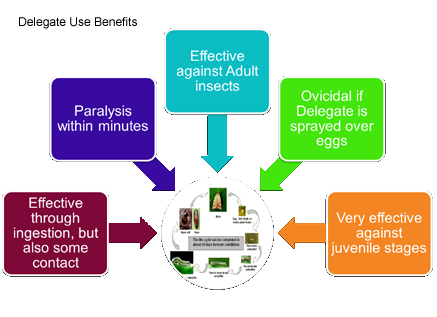 In spite of great advances in insect-pest control strategies, thrips still remains to be one of the most challenging pests to control across the world. Dr Arturo Golderacena of Catholic University of Louvain, Belgium discussed this issue during a two-day seminar organised for flowers and vegetable growers by Dudutech and Dow Agrosciences. The combined approach by One of the Leading global Insecticide Giants and a globally respected Biological Solutions Innovator proved no one can walk alone.
In spite of great advances in insect-pest control strategies, thrips still remains to be one of the most challenging pests to control across the world. Dr Arturo Golderacena of Catholic University of Louvain, Belgium discussed this issue during a two-day seminar organised for flowers and vegetable growers by Dudutech and Dow Agrosciences. The combined approach by One of the Leading global Insecticide Giants and a globally respected Biological Solutions Innovator proved no one can walk alone.
What Are Thrips
Thrips (order Thysanoptera) are one of the most widespread, economically damaging and difficult pests to control worldwide. They are one of the smallest known winged insects and are named after their fringed/eyelash like wings. They cause damage to plants by piercing the cells of surface tissues and feeding on the sap. This causes the cells to die leaving unsightly sunken white blotches on leaf surfaces. Leaves may also be deformed and blossoms damaged by feeding in flower buds or on surface new vegetative growth. Thrips also transmit deadly viruses like Impatiens Necrotic Spot Virus (INSV) and Tomato spotted wilt virus (TSWV) that can devastate numerous crop varieties.
An high propensity of thrips in developing insecticide resistance has been attributed to its biological attributes. Indeed, thrips have proven notoriously difficult to control owing to their small sizes, high rates of reproduction and cryptic habits. A female thrips can produce up to 140 eggs (at 25oC). This quickly leads to great numbers of thrips infesting individual plants. An infestation of thrips may begin through insects being introduced into the greenhouse along with planting material and later in the season, adult thrips may fly from outside. The spread of thrips can be both active (flight) and/or a passive process (floating on air currents).
Monitoring
Scouting/monitoring is the regular and systematic inspection of crops and other detect ion tools (sticky cards, etc.) to identify insect pests, diseases, nutrient deficiencies and other problems. It is a corner stone of effective IPM. How can you manage your pest problems if you don’t know what’s there? A sound scouting program provides, an early detection of pest problems, and locates areas prone to problems; trends in the population levels of the pest or biological control agent; enables the grower to identify the optimal time and method for treatment; and measures the effectiveness of a management action (biological control or chemical insecticide treatment). A grower must develop a scouting program that works for him/her, taking into consideration how much time is available, and the severity of past pest problems.
 An effective scouting program will save time and money in the long run by allowing the grower to manage problems early. It is best to use a consistent approach, even if time is short.
An effective scouting program will save time and money in the long run by allowing the grower to manage problems early. It is best to use a consistent approach, even if time is short.
What are the Damage symptoms?
In Flowers there are mainly two types of Thrip species that attack Roses, Carnations and other flowers. The western flower thrips (Franklieniela occidentalis) and Thrips tabaci also known as Onion thrips. These thrips species mainly feed on both leaves and flower petals with the majority of their damage to roses occurring throughout the growing period of the flowers. Their feeding may result in distorted buds that open only partially or abort prematurely. Feeding on petals may result in petals streaked with silvery-white or brown as well as petals with browning edges. White and light-colored rose blossoms appear to be particularly attractive to thrips. Young leaves may be distorted and flecked with yellow as a result of thrips feeding.
Management
Thrips are difficult to control. Always use an integrated program that combines the use of good cultural practices, natural enemies, and the most effective IPM-friendly available.
Why an integrated management approach for thrips?
As highlighted earlier, insecticide resistance is just one the issues growers have to contend with in control of thrips. Increasingly, growers are facing more stringent market demands with mounting pressure to reduce the number of molecules and observe maximum residue levels (MRLs) on their produce. This turn of events has of course cast growers in an unenviable situation. The reality is that no single control measure can effectively manage thrips population and this calls for an emphasis on an integrated management approach. In order to counter insecticide resistance in the western flower thrips, several insecticide resistance management (IRM) programs have been developed around the world. The core objective of IRM programs is to maximize the lifespan of efficacy for insecticides. Research has shown that successful IRM programs rely on noninsecticidal tactics, such as biological and cultural controls and host plant resistance to reduce population pressures. Also of importance is the rotation among insecticides of different mode of action classes, resistance monitoring, sampling to determine the need for insecticide applications and education to assure proper implementation. Growers need to adopt a proactive rather than a reactive approach in implementation of IRM programs in order to maximize their chances of success. The focus should be on more judicious insecticide use, and this can be accomplished with the development of well-founded economic thresholds.
Chemical control.
While speaking in the same seminar, Mr. Oscar Shilliebo of Dow Agrosciencies informed growers the company has some of the best molecules against Thrips if well used to avoid resistance. One of the best, and most effective insecticides that fits this profile is Delegate. Spinetoram (DELEGATE 250WG) is a second generation active from the spinosyn family. This product has improved residuality, improved photostability, improved speed of activity (fast knockdown), ovicidal activity when sprayed on eggs (Caterpillars), improved spectrum and has translaminar activity and safe to beneficial insects that are not in contact with the wet spray. In addition to control of Thrips the product also controls Caterpillars (Spodoptera exigua), whitefly nymphs and leaf miner.
Biological control
Dudutech took growers through a range of their solutions for thrips. Biological control of thrips relies on the use of natural enemies including predatory mites and pirate bugs, entomopathogenic (or insect-killing) fungi, and entomopathogenic nematodes.
Predatory mites
The predatory phytoseiid mites, Amblyseius cucumeris, Iphiseius degenerans, and A. swirskii, are well suited for immature thrips control on greenhouse crops. Like thrips, they prefer small niches where contact between predator and prey is maximized. These predators feed on pollen when thrips populations are low and must be introduced before a thrips population has built up to damaging levels. The mites establish themselves on leaves, usually on the undersides, and are most effective in attacking 1st instar thrips nymph. They use their mouthparts to pierce the thrips and suck out the cellular fluids.
The predatory mite Amblyseius cucumeris (AMBLYTECH C®) regulates thrips populations by feeding on the 1st and 2nd instar nymphs. It should be applied on tender shoots and applied frequently based on pest pressure.
Pathogens  Several pathogens have been investigated for control of thrips. The entomopathogenic fungus Beauveria bassiana (BEAUVITECH®) has been shown to be very effective in managing thrips populations in cutflowers where relative humidity is high. The fungus is capable of infecting both adult and juvenile thrips. Frequent usage will ensure the fungus is present on most crop foliage affecting juvenile and adult thrips. After application allow 24 hours before spraying a fungicide. The product is compatible with most insecticides.
Several pathogens have been investigated for control of thrips. The entomopathogenic fungus Beauveria bassiana (BEAUVITECH®) has been shown to be very effective in managing thrips populations in cutflowers where relative humidity is high. The fungus is capable of infecting both adult and juvenile thrips. Frequent usage will ensure the fungus is present on most crop foliage affecting juvenile and adult thrips. After application allow 24 hours before spraying a fungicide. The product is compatible with most insecticides.
Entomopathogenic nematode Steinernema feltiae (NEMATECH S®) is effective in infecting the soil-dwelling prepupal and pupal stages. The nematode also kills sciarid flies larvae in the soil.
In conclusion…
Thrips has been, and still is, a difficult insect pest to control or regulate in greenhouse production systems leading many to believe that we have reached an impasse regarding its management. Dealing with thrips, therefore, requires a holistic approach integrating the methods detailed above. Key in this approach is knowledge about the biology of the pest, and indeed all other relevant pests, the crop (s), the cropping systems, pest management options etc. Dow Agrosciencies and Dudutech’s have derived sustainable pest management solutions backed up by training courses covering these very topics. Knowledge, we believe is the best weapon.
